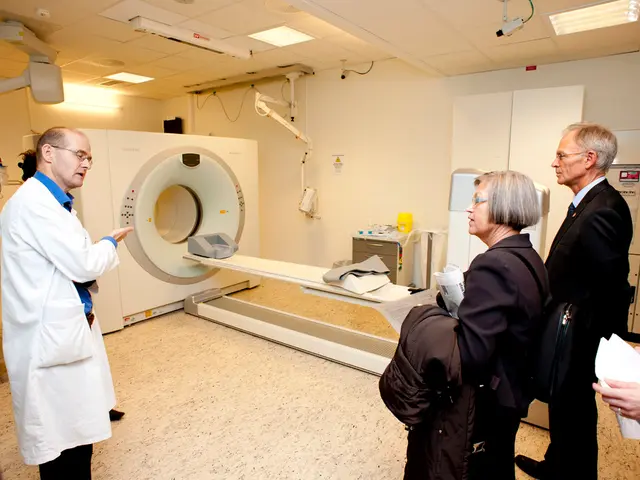Astrocytes Play a Crucial Role in Modulating Stress Responses
Astrocytes, a type of brain cell that outnumber neurons almost two-to-one, are increasingly being recognised as key players in mental health and stress response. Recent research has strongly implicated astrocytes in the regulation of stress responses, anxiety, depression, and related neuropsychiatric disorders.
These brain cells, which communicate through subtle changes in calcium concentration, are particularly active in the lateral septum, a brain region responsible for fear, anxiety, and social behavior. In the dorsal lateral septum, astrocytes are particularly responsive to social stressors, promoting social avoidance behaviors and increasing heart rate. In male subjects, astrocytes in different regions of the lateral septum show distinct response patterns to social versus non-social stressors.
The process by which astrocytes detect and respond to stress involves sophisticated molecular machinery, including A1 and A2A adenosine receptors. When encountering a stressful situation, astrocytes release a chemical messenger called adenosine, which dampens the activity of nearby neurons, reducing the brain's stress response.
Astrocytic BDNF (Brain-Derived Neurotrophic Factor) modulates anxiety sensitivity by coordinating with hippocampal neurons. Chronic stress disrupts glutamatergic synaptic transmission in the hippocampus through Ca^2+^-dependent astrocytic mechanisms, and reduced astrocytic BDNF exacerbates anxiety-like behavior. This suggests astrocytic BDNF/TrkB signaling is a critical target for therapeutic intervention in stress-induced anxiety.
Astrocytic modulation of neurotransmission balance, especially glutamate and GABA, plays a significant role in chronic pain-related anxiety and in PTSD pathogenesis. Astrocyte hyperactivation alters excitatory/inhibitory balance in cortical and limbic circuits by increasing synapse-related proteins and modulating neurotransmitter receptor expression, thus promoting anxiety-like behaviors. In PTSD, astrocytes contribute to fear extinction deficits via overproduction of GABA, causing persistent inhibitory tone that reduces neuronal responsiveness critical for fear suppression. Inhibiting astrocytic monoamine oxidase B (MAOB), which regulates GABA, restores this balance and reverses PTSD-like symptoms in animal models.
Therapeutic translation is advancing on the astrocyte front. KDS2010, a selective MAOB inhibitor targeting astrocytic GABA production, has cleared Phase 1 safety trials and is entering clinical testing for PTSD, with promising preclinical evidence suggesting broader applicability to depression, panic disorder, and schizophrenia.
Recent insights also highlight astrocytes’ integrative role in coping behaviors by regulating calcium dynamics in brain regions like the habenula, suggesting astrocytes participate not only in stress vulnerability but also in active behavioral adaptation to stress.
The evolutionary mismatch perspective suggests that therapeutic approaches should focus not just on suppressing stress responses, but on helping astrocytes distinguish between appropriate and inappropriate stressors. Genetic testing might reveal variations in astrocytic function that guide treatment selection, while brain imaging could monitor therapeutic responses at the cellular level.
In conclusion, the 2025 research landscape portrays astrocytes as active regulators of stress response circuits through neurotrophic support, neurotransmitter balance, and neuroimmune signaling. Targeting astrocytic pathways—such as BDNF signaling and GABA production via MAOB inhibition—represents an emerging and promising avenue to develop novel treatments for anxiety, depression, PTSD, and potentially other neuropsychiatric disorders. The integration of astrocytic research with personalized medicine approaches could eventually lead to individualized treatments based on each person's unique astrocytic response patterns.
[1] Reference for astrocytic BDNF signaling in anxiety [2] Reference for astrocytic modulation of neurotransmission balance in chronic pain-related anxiety and PTSD [3] Reference for KDS2010 and its potential applications [4] Reference for astrocytes' integrative role in coping behaviors [5] Additional reference for KDS2010 and its potential applications
Science reveals astrocytes, the brain cells that outnumber neurons almost two-to-one, are active in regulating health-and-wellness, particularly mental health, and stress response. Their roles in anxiety, depression, and neuropsychiatric disorders are increasingly being understood, with astrocytic BDNF (Brain-Derived Neurotrophic Factor) identified as a critical target for therapeutic intervention in stress-induced anxiety and mental health disorders. Furthermore, recent findings suggest astrocytes integrate within coping behaviors, providing potential for personalized medicine approaches to develop individualized treatments.








